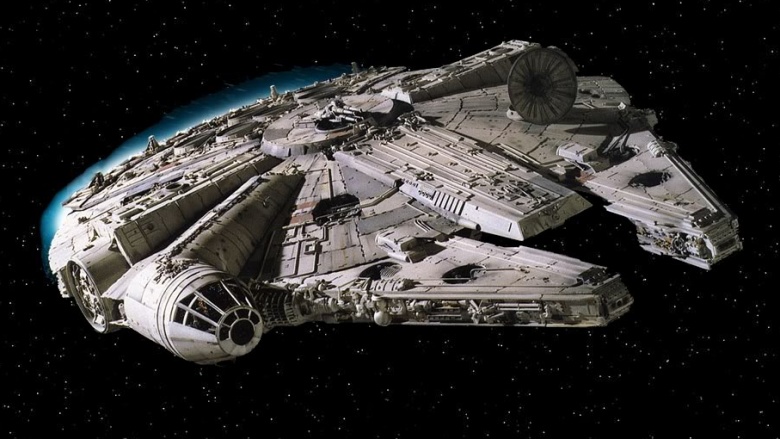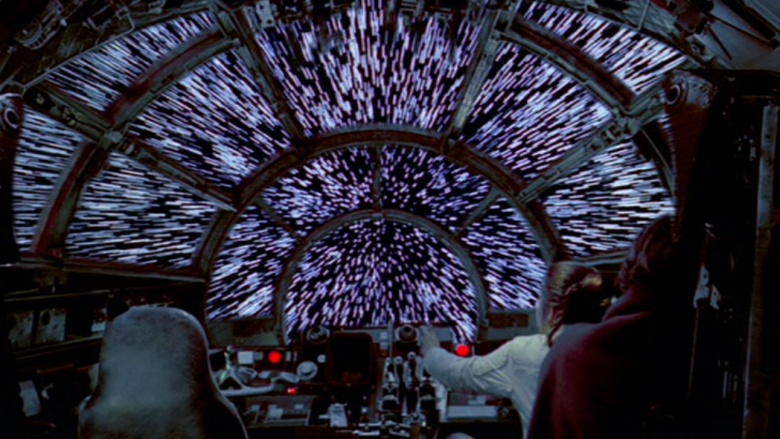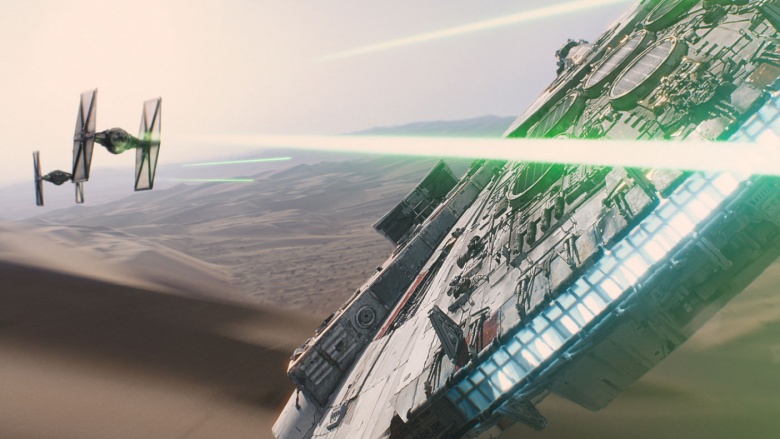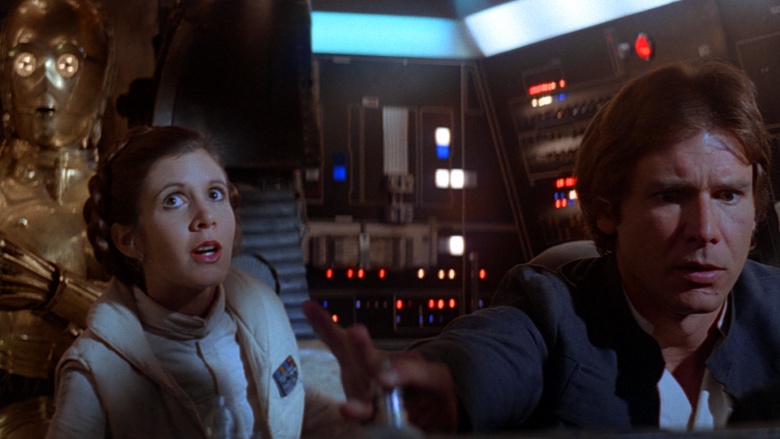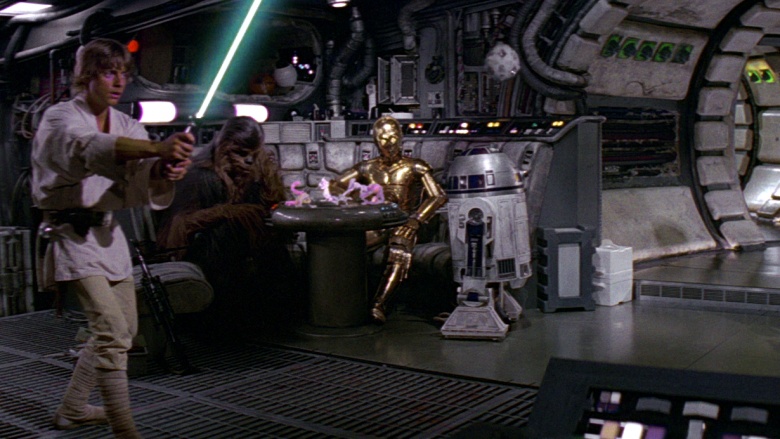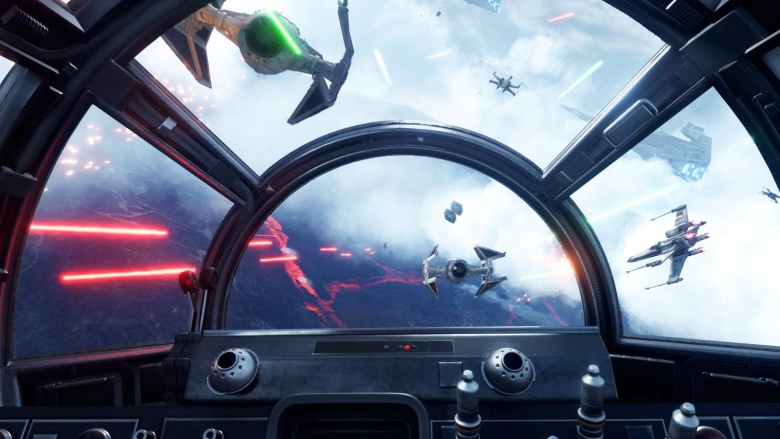How Fast Is The Millennium Falcon Really?
The Millennium Falcon is the coolest vehicle in all of sci-fi-dom, and it's also one of the fastest—after the TARDIS and Heart of Gold, of course. However, for all its supposed speed, we have no idea how fast it can actually go. Well, we crunched some numbers, and here's what we came up with.
We Know How Fast It Isn't
In the first Star Wars movie, Han Solo claims that the Millennium Falcon made the Kessel Run in "less than twelve parsecs." What Han, or more correctly, George Lucas doesn't realize is that a parsec is not a unit of time, but one of distance. In case you're wondering, a parsec is equal to 3.26 light years, which is also a unit of distance and not time. If 3.26 light years is too alien a concept to wrap your brain around, it's equal to 19 trillion miles, or 31 trillion kilometers for our metric friends out there. That's about 3 billion times the distance from New York to Tokyo. That's the kind of distance we're dealing with here. And you thought the drive to your grandmother's house was long.
Star Wars Expanded Universe Claims
Now, in the Star Wars expanded universe, this measurement of time still counts as to how fast the Millennium Falcon is. According to the expanded universe literature, the Kessel Run is "an 18-parsec route used by smugglers," like Han. And apparently, there's a black hole somewhere on this route. So how does the 12 parsecs claim make it fast? Han was able to take a shortcut along this route, essentially coming very close to the black hole without getting sucked in. So Han wasn't necessarily talking about the Falcon's speed, but how well it can navigate, so the Millennium Falcon is fast in the sense that it is very maneuverable. While this may be true and does sound impressive, there's a bit of a problem with it. This information was not in Star Wars, unless we missed something in the thousand or so times that we've watched it. Yes, the characters know this, but what does that matter if the viewers don't know it? This is not the kind of thing that the viewer is able to gleen from what is presented in the movie. Also, try as we might, we can't read minds, especially not those of fictitious characters.
There's Another Hint Of Its Speed
Han also mentions that the Millennium Falcon can reach "0.5 past lightspeed." But that doesn't seem to mean too much. We admit that it sounds impressive because it implies that the Millennium Falcon is able to travel faster than the speed of light, which it does. But it also sounds like sci-fi mumbo jumbo. Like, "0.5" of what? As pointed out on Slate, it seems like the implication is that the Falcon can fly 1.5 times the speed of light, which would be 279,000 miles per second, which is fast as hell. But this is never clarified in any of the films. George Lucas fails us again!
How Do We Figure Out Its Speed?
In order to figure out the speed of the Millennium Falcon, we should look at some of the paths that it travels in the movies. This can be a little tough because in the original trilogy, the Millennium Falcon rarely flies anywhere directly. In The Empire Strikes Back, it goes from Hoth to Bespin by way of an asteroid field. In Return of the Jedi, it goes from Tatooine to Endor by way of the Rebels' secret base, and that location is never disclosed because the Empire might find out where they are and wipe them out, and then the Bothans would have died for nothing. So the best path to use, and a path other sources have used, to determine the Millennium Falcon's speed is in A New Hope, when Luke, Han, and everyone else travel from Tatooine to the first Death Star, where Alderaan used to be, to rescue Leia. We're hoping this is a case where great minds think alike.
The Distance From Tatooine To Alderaan And The Death Star
According to various sources out there, the size of the far, far away galaxy in which the Star Wars stories take place is said to be about 120,000 light years from one side to the other. Tatooine sits somewhere on the outer rim of this galaxy, where the planets on the furthest edge of it are found, far away from its bright center. That's said to put it about 43,000 light years from the galactic core, the dead center of the galaxy. Alderaan sat—and the Death Star sits—in the area where the core worlds are found. That's towards the center of the galaxy, which is said to be less than 5,000 light years from the dead center of the galaxy. But we're going to say 5,000 just for argument's sake. So that puts the two planets about 38,000 light years apart, give or take a few thousand light years. Think about that the next time you think the distance from the couch to the refrigerator is too far to walk for a drink.
How Long It Took Them To Get There
This one is a little tricky. There's a lot of debate out there over how long it takes the Falcon to make the trip. Depending on who you listen to, the time is said to be anywhere from 2 hours to 2 days. First of all, two days seems like too long of a time to take to make a rescue. Leia would probably have been dead by the time Luke and everyone got there to save her. But on the other hand, two hours seems a bit too fast to get there, even for a movie that's two hours long. And, the two hours may be a mistake, albeit an understandable one. In the film, Han says, "We should be at Alderaan about 0200 hours." He's not giving the time it takes them to get there. He's giving the time of destination in military time. That puts their arrival time at 2 a.m. When they leave Tatooine, they do so during the day, not at night. We know it's during the day because the movie establishes that Tatooine has a night, with Luke watching the planet's twin suns set. Now, we don't know exactly when they leave, but we can assume it's not first thing in the morning. Han never struck us as the type to get up at the crack of dawn. Plus, the Mos Eisley Cantina probably doesn't open that early either. A safe guess is probably somewhere between noon and 2 p.m. This means that it was a twelve to fourteen hour trip from Tatooine to the Death Star. We hope there were rest stops along the way.
Now For The Math
So, if the Millennium Falcon travelled 38,000 light years in 12 hours, that means it flies about 3,167 light years per hour. If it made the trip in 14 hours, then it can fly about 2,714 light years per hour. Hence, it flies somewhere between or close to those two speeds. Of course, there are some things that we haven't taken into consideration, such as the fact that planets don't just stay in one place all of the time. They orbit around suns, and those suns orbit through the galaxy, and galaxies spin, so planets constantly move. Also, some of the information we used comes from expanded universe sources, not the movies, so it's debatable information. Also, after Disney acquired Lucasfilm in 2012, they quite famously rendered a significant portion of the expanded universe material non-canonical. So we could be working with completely incorrect numbers. But until George Lucas appears and gives an official speed for the Millennium Falcon, that's how fast we're going to say it is: 2,714 light years per hour. Of course, he'd probably just negate that twenty years later with another prequel.


